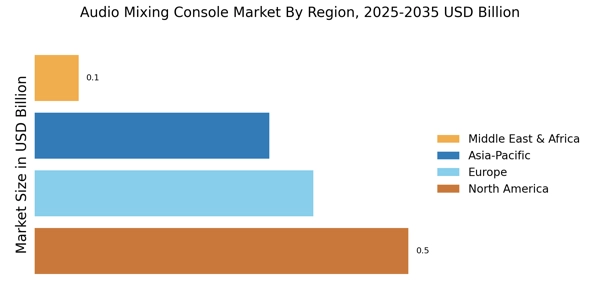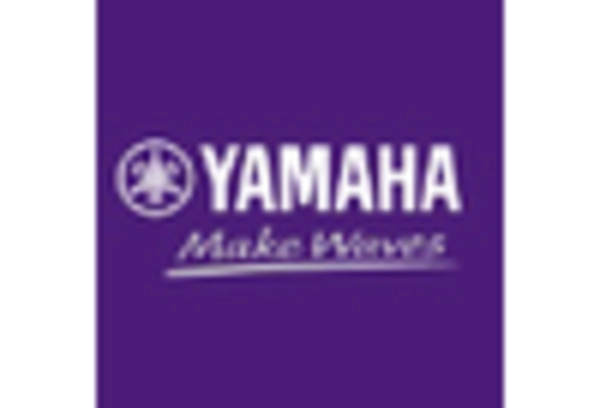Growth of Home Studios in Audio Mixing Console Market
The Audio Mixing Console Market is significantly influenced by the burgeoning trend of home studios. With the democratization of music production, more individuals are investing in home studio setups, which often include high-quality audio mixing consoles. This trend is supported by the increasing availability of affordable yet professional-grade equipment, enabling aspiring musicians and producers to create high-quality audio from the comfort of their homes. Recent statistics indicate that the home studio market has expanded by approximately 7% annually, contributing to the overall growth of the audio mixing console sector. As more creators seek to produce music independently, the demand for versatile and compact mixing consoles is expected to rise, further propelling the market forward.
Rise of Remote Production in Audio Mixing Console Market
The Audio Mixing Console Market is witnessing a significant shift towards remote production capabilities. This trend is largely influenced by the increasing need for flexibility and efficiency in audio production processes. Remote production allows sound engineers and producers to collaborate from different locations, utilizing advanced audio mixing consoles equipped with cloud-based technologies. This shift is reflected in the growing adoption of remote mixing solutions, which are expected to account for a substantial portion of the market share in the coming years. The convenience of remote access to high-quality audio mixing tools is appealing to both professionals and hobbyists alike. As a result, the demand for audio mixing consoles that support remote production is likely to rise, further driving market growth.
Technological Advancements in Audio Mixing Console Market
The Audio Mixing Console Market is experiencing a notable transformation due to rapid technological advancements. Innovations such as digital signal processing, enhanced connectivity options, and user-friendly interfaces are reshaping the landscape. The integration of artificial intelligence and machine learning into mixing consoles is streamlining workflows and improving sound quality. According to recent data, the market for digital mixing consoles is projected to grow at a compound annual growth rate of approximately 5.2% over the next five years. This growth is driven by the increasing demand for high-quality audio in various sectors, including music production, broadcasting, and live events. As technology continues to evolve, manufacturers are likely to invest in research and development to create more sophisticated and versatile audio mixing solutions.
Emergence of Streaming Platforms in Audio Mixing Console Market
The Audio Mixing Console Market is being shaped by the emergence of streaming platforms that require high-quality audio production. As content creators increasingly turn to platforms for music distribution and live streaming, the demand for professional audio mixing consoles is on the rise. These platforms necessitate superior sound quality and seamless integration with various audio sources, prompting producers to invest in advanced mixing solutions. Recent data suggests that the market for audio mixing consoles tailored for streaming applications is expected to grow by approximately 4.5% annually. This growth is driven by the need for content creators to deliver polished audio experiences to their audiences, thereby enhancing the overall appeal of their productions.
Increased Demand for Live Sound Events in Audio Mixing Console Market
The Audio Mixing Console Market is experiencing heightened demand due to the resurgence of live sound events. As public gatherings and performances regain momentum, the need for high-quality audio mixing solutions becomes paramount. Event organizers and sound engineers are increasingly investing in advanced audio mixing consoles to ensure optimal sound quality during live performances. This trend is reflected in the projected growth of the live sound reinforcement market, which is anticipated to expand at a rate of 6% over the next few years. The emphasis on delivering exceptional audio experiences at concerts, festivals, and corporate events is likely to drive the demand for innovative mixing consoles that can handle complex audio requirements.


















Leave a Comment